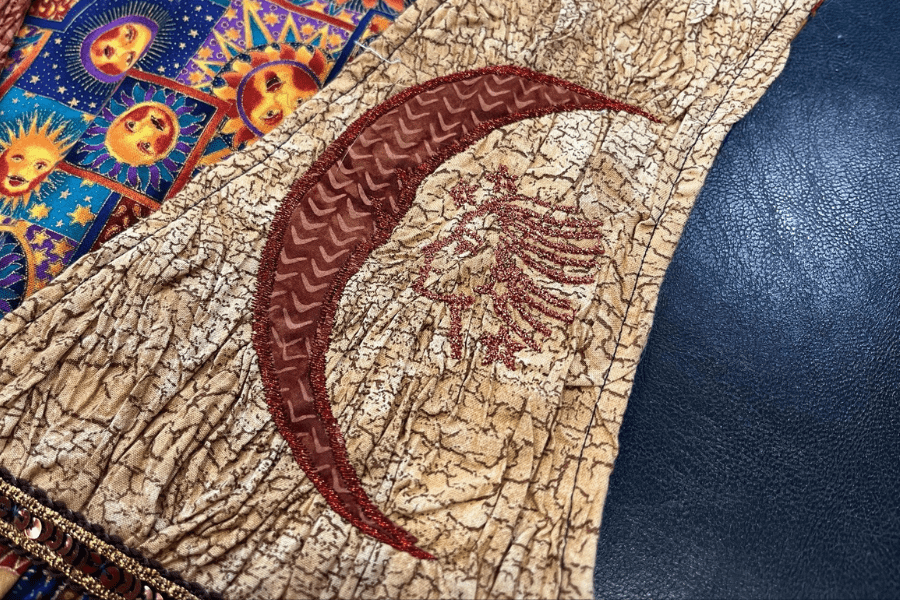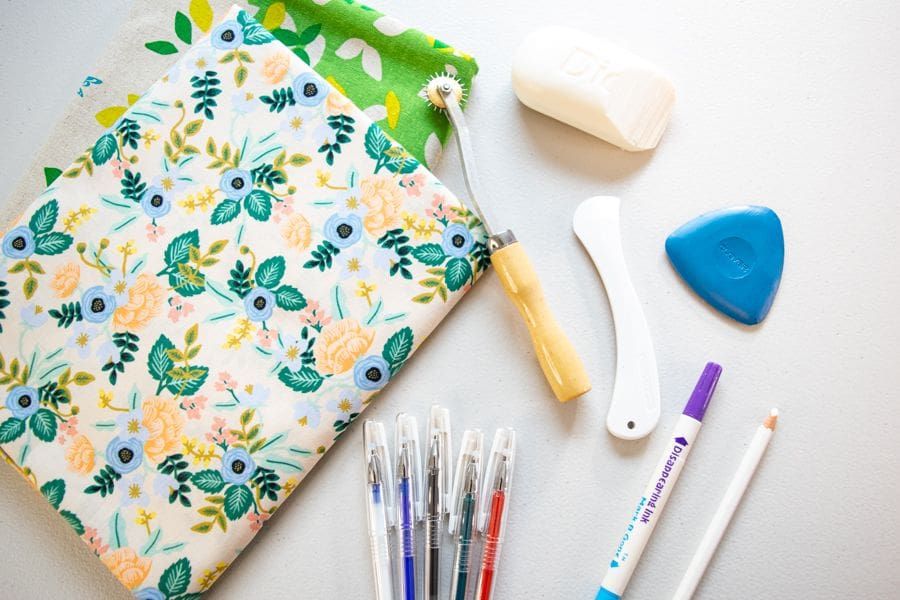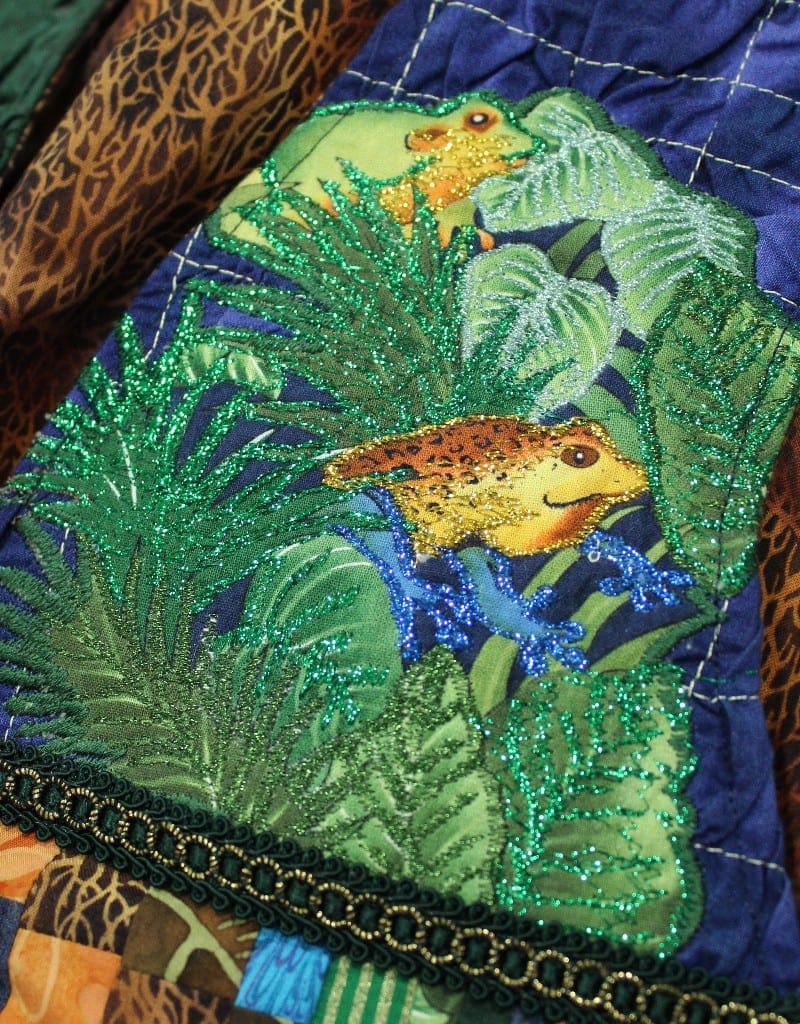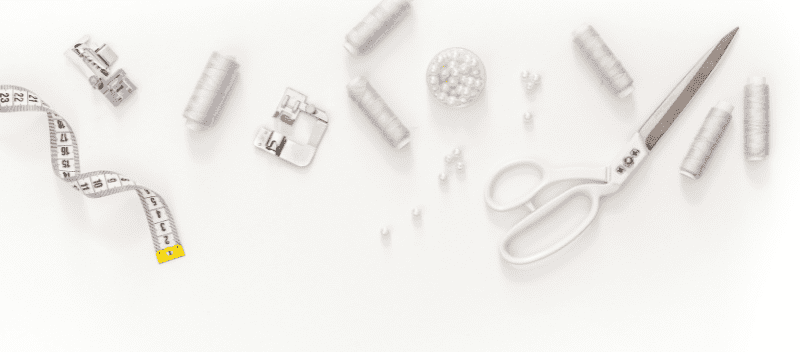How to Easily Sew a Beautiful & Technically Perfect Satin Stitch
For many novice sewists, the thought of sewing a satin stitch is stressful. However, if you understand a few basic techniques, you too can achieve beautiful, professional looking results.
What is a ‘satin stitch?’
A satin stitch is a flat, tightly sewn zig-zag stitch where the thread appears to be placed in neat, parallel lines. When sewn correctly, no background fabric is visible thru the stitching.
How to sew a satin stitch
Start by selecting a suitable decorative thread for your project. A 30 or 40 weight rayon or polyester thread is best for satin stitching. General sewing utility threads are not recommended. If you are looking for more glitz or impact, consider using a metallic or color shifting thread. One note of caution when working with metallics, these threads can be challenging to sew with so tools like ‘Sewers Aid’ or larger eyed sewing needles can be helpful.

You will also need to use a special bobbin thread. Sulky makes a great bobbin thread for applique and satin stitching that is available in two colors, black and white. It is a thinner thread (60 weight) and helps achieve better sewing results. Since this thread isn’t visible, select the color that works best with your decorative thread. In most cases, you can use white bobbin thread for almost all projects.
Once you have your sewing machine threaded, it’s time to turn it on and select the zig zag stitch. If your machine has an ‘applique stitch’, go ahead and select it. (NOTE: Machines with a built-in applique stitch may not need the stitch length adjusted.) Before sewing, you MUST adjust your sewing length and width. First, let’s adjust the sewing length. Typically, a nice tight satin stitch has a stitch length between 0.2 and 0.3mm length. Just realize that the tighter the stitch, the longer it will take to sew it out. It is advisable to experiment with the stitch length on a scrap piece of fabric to determine which stitch length will work best for your project. Once you have the length set, it’s time to adjust the stitch width. There is NO required or standard satin stitch width—this is a personal preference. Typically, if you are sewing around small fabric pieces, the stitch width will be narrower, somewhere between 1.5mm to 2.0mm. When sewing around larger pieces, the stitch width will be between 2.2mm and 6.0mm. It is not advisable to use a very wide stitch for everything. It’s often best to stay somewhere between 2.0mm to 3.5mm. Again, experiment with the width on your scrap fabric before sewing your actual project.

Before sewing the satin stitch on your project, it’s important to stabilize your fabric. There are three simple ways to do this:
- Apply a layer of tearaway iron-on stabilizer to the wrong side of your fabric. (Sulky has a great tear away called “Totally Stable” that I use on almost all of my satin stitching projects.)

- Lightly starch your fabric, use a free floating, tear away stabilizer on the reverse side of your project. (This method is more difficult and I don’t recommend it for Beginner/Intermediate Sewists).
- My preferred method is to apply one layer of the iron-on tear away stabilizer and use a single layer of free-floating tear away stabilizer for additional support. I’ve always had GREAT results using this method and it helps to get those professionally sewn results!
Once you correctly have set-up your machine, it’s time to start sewing! To begin, turn the stitch width AND length to ‘zero’. Sew 2-3 locking stitches.

Next, turn the width and length to your desired settings. Sew your seam. Once you reach the end, turn the width and length to ‘zero’. Sew 2 to 3 locking stitches. Lift your presser foot and snip your threads. Congratulations! You have sewn your satin stitch! Simply repeat this process until you have sewn all the elements on your project. After all elements are sewn, carefully remove your tear-away stabilizers.

NOTE: If you are using the satin stitch to applique pieces to a background fabric, you will want to pay attention to stitching placement. Follow the 90/10 rule. 90 % of your stitching placement should be on your applique piece and 10 % should be off it on the background fabric. The easiest way, to think of it is to use this reference: think of your applique piece as a sidewalk. If you step off the side walk onto the street, you don’t place your heels against the sidewalk when stepping down, you give yourself a few inches of space. While you want your stitching close to the edge of the applique piece, you do not want it against the edge. Having a tiny buffer allows you to achieve better results.

Satin Stitch Frequently Asked Questions
Do you need a special presser foot to sew a satin stitch?
Technically, no, you do not need a special presser foot, but it is much easier to create the satin stitch using an ‘open toe’ or ‘applique’ presser foot so you can see the stitching in real time. Depending on the sewing machine brand you are using, there may be more than one applique foot available. Brands like Bernina offer different versions so that sewists can achieve optimal results for their specific sewing project need.

Do you need a special sewing machine needle?
No, you do not need a specific needle, but for best results, use an applique, sharp, or embroidery sewing machine needle.
My bobbin thread is showing on the top. How do I correct this, so it doesn’t show?
Exposed bobbin thread indicates a tension problem. You will need to tighten your bobbin tension on your machine so that it ‘pulls’ more of the decorative thread to the underside of your fabric. Consult your sewing machine’s manual to determine the correct procedure for tightening the bobbin thread. Generally speaking, it is best to see a small amount of your decorative thread on the underside. The less bobbin thread showing indicates how tight you have the tension set. If it looks like a single line of bobbin thread, then the tension is too tight and needs loosened.
Do I need to ‘lock’ my stitching at the beginning and ending of every seam?
Yes, it is very important to secure your stitching so that it doesn’t unravel.
I hope this tutorial helped you with satin stitching. If so, please consider sharing it on social media and with your sewing friends. If you have a question, please leave it in the comments below.
Please note: This article does contain affiliate links.
We are a participant in the Amazon Services LLC Associates Program and its affiliate advertising programs which are designed to provide a means for us to earn fees by linking to Amazon.com and its affiliated sites.
There is no additional cost to you when you make a purchase through any of my affiliate links.
CHRISTINE WARREN
Sewing isn’t just my job, it’s my passion. I’ve enjoyed sewing and needle working since I was very young.















